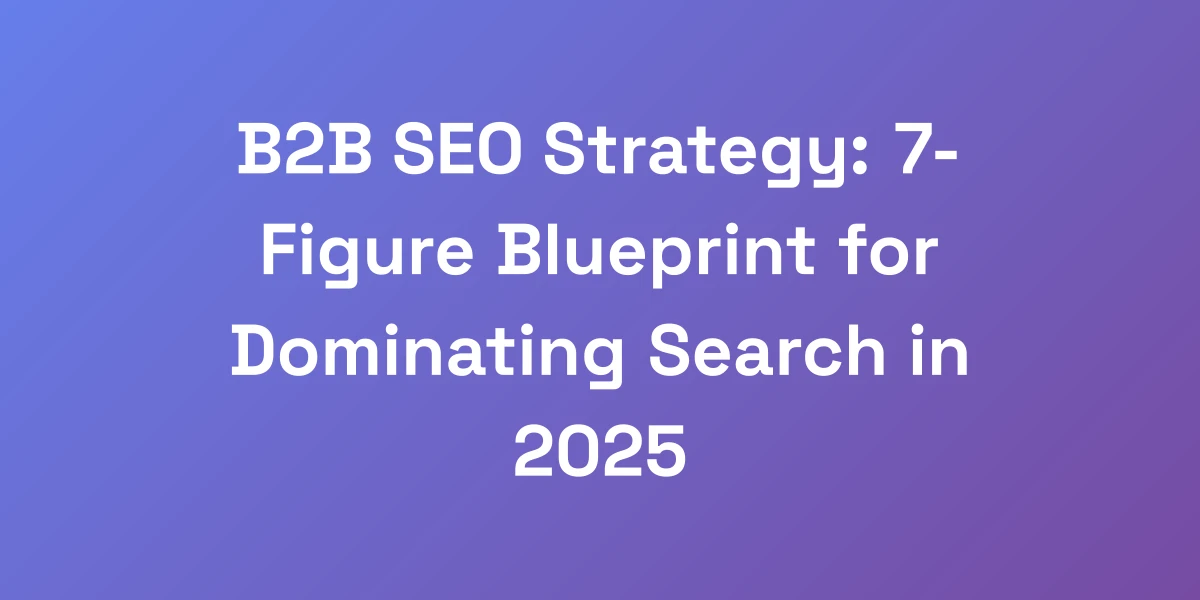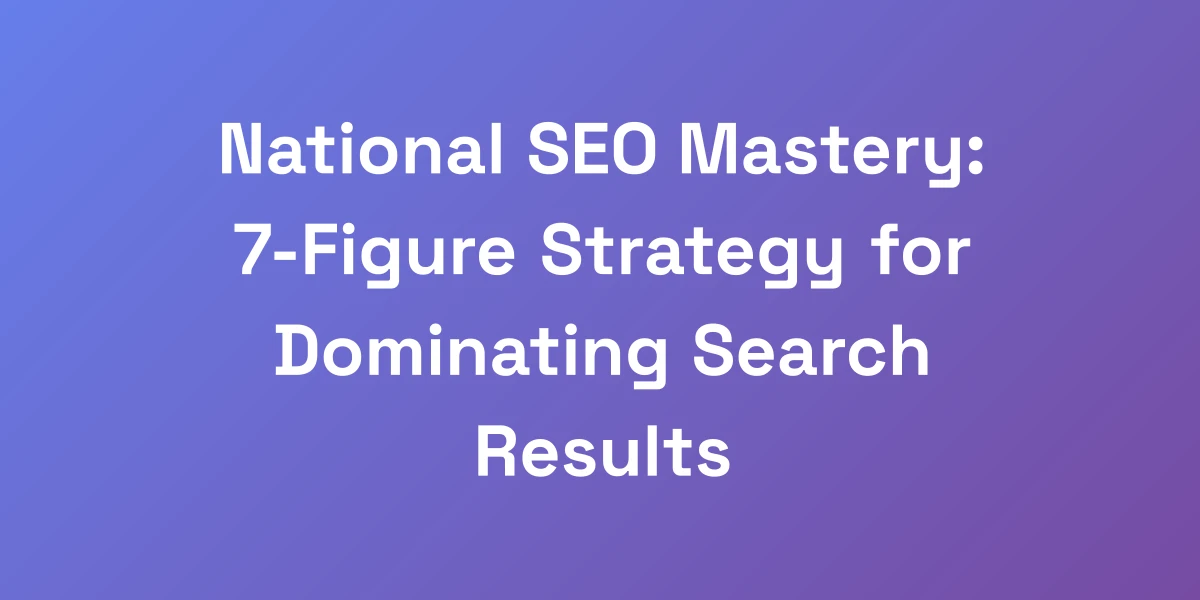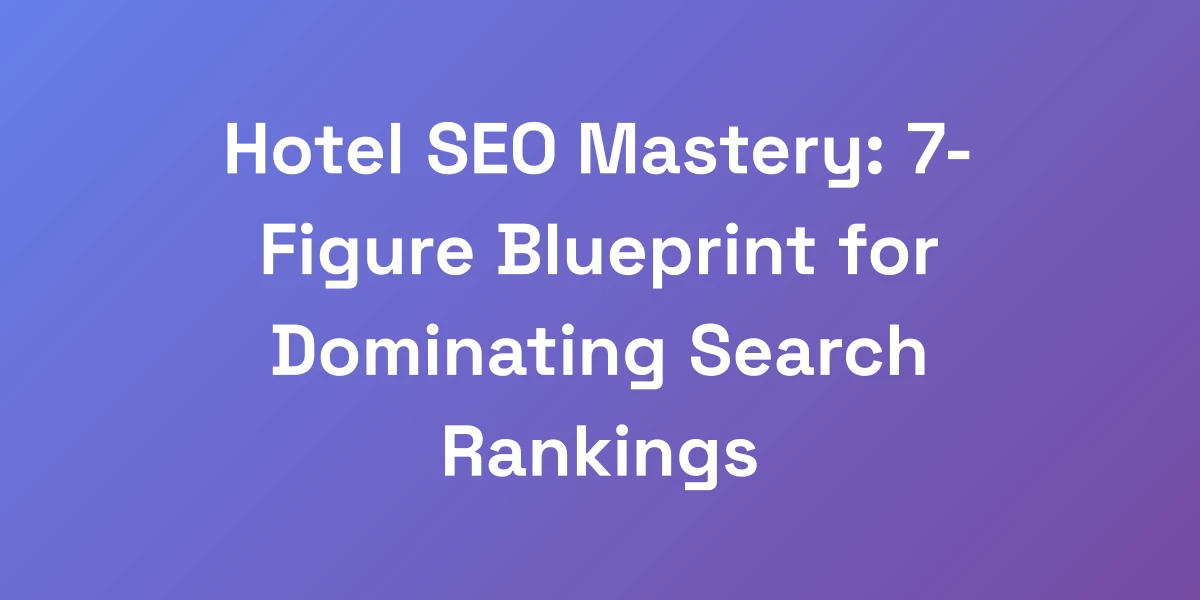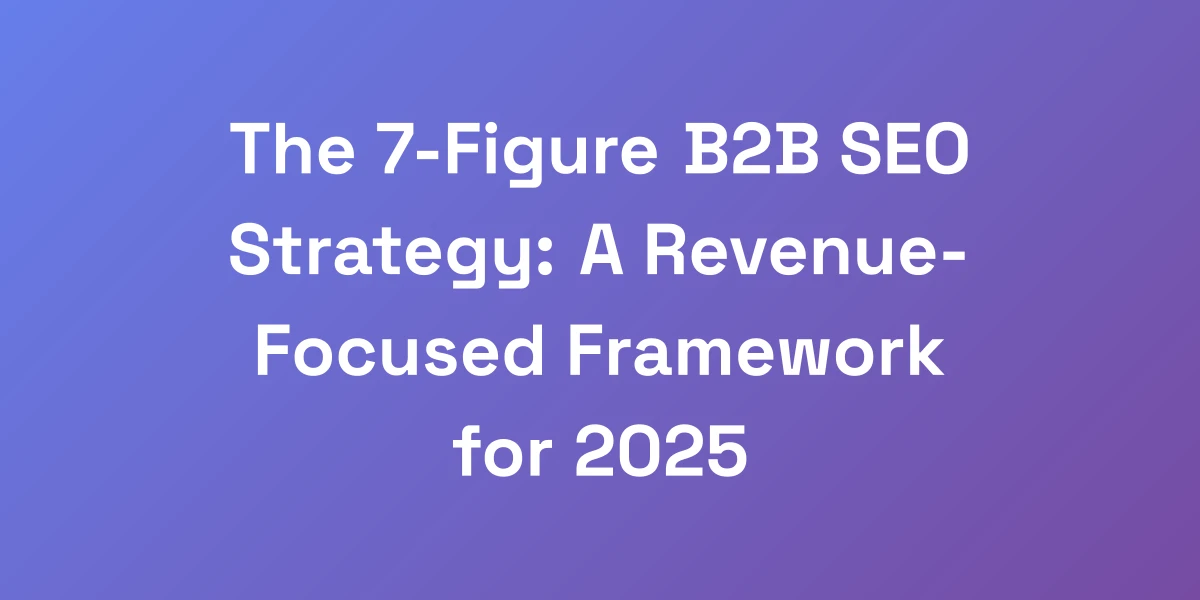
B2B SEO Strategy: 7-Figure Blueprint for Dominating Search in 2025
Mar 23, 2025 | By [email protected]
Why Most B2B Companies Fail at SEO (And How to Win)
Listen, I’m going to be straight with you – 90% of B2B companies are throwing money down the drain with their SEO efforts.
They’re focusing on vanity metrics and generic keywords that don’t convert.
Here’s the truth: B2B SEO isn’t about traffic, it’s about revenue.
In our years of scaling companies, we’ve discovered that the real money is in strategic intent-based optimization that targets decision-makers when they’re ready to buy.
Ever wondered why some companies just nail their SEO while others struggle?
It’s not luck. It’s strategy.
Let us show you exactly how the top 1% of B2B companies are crushing it with SEO.
The Critical Difference Between B2B and B2C SEO
Many businesses mistakenly apply B2C SEO tactics to their B2B strategies, thinking it’s a one-size-fits-all solution.
But B2B SEO requires a different approach.
It’s about targeting long-term relationships and high-value transactions rather than quick wins and impulse buys.
For instance, while B2C might thrive on high-volume keyword strategies, B2B needs to focus on niche keywords that resonate with industry-specific pain points.
Here’s a tip: shift your focus from broad terms like “buy software” to more specific queries like “enterprise CRM solutions for healthcare.”
This precision not only attracts the right audience but also significantly boosts your conversion rates.
Implementing a robust B2B SEO strategy is essential for targeting these high-value transactions effectively.
Understanding the B2B Buyer’s Journey
In B2B, the buyer’s journey is often intricate and multi-faceted, involving multiple stakeholders and an average sales cycle length by industry.
We need to align our SEO strategies with each stage of this journey.
Top of the funnel requires educational content that addresses common pain points, while the bottom of the funnel demands detailed product comparisons and case studies.
Imagine a buyer researching solutions for their company’s operational inefficiencies.
At the awareness stage, they might search for “how to improve business operations,” while at the consideration stage, queries like “best business operation software” take center stage.
By mapping your content to these stages, you’re not just attracting visitors; you’re guiding them through a well-structured pathway towards conversion.
Common SEO Mistakes Costing You Millions
Let’s identify where most B2B companies are going wrong.
First, targeting generic keywords that attract traffic but lack conversion potential.
Second, neglecting technical SEO aspects like site speed and mobile optimization, which can drastically affect user experience and rankings.
Third, inconsistent content updates that fail to keep up with industry trends and search engine algorithms, as discussed in Google algorithm updates.
Fourth, poor backlink strategies that either don’t add value or harm your site’s authority.
For example, relying on low-quality guest posts can tarnish your site’s reputation and reduce trust among potential clients.
We recommend a thorough SEO audit to uncover these pitfalls and address them systematically, ensuring your SEO efforts translate into real revenue.
The ROI-First Approach to B2B SEO
We approach SEO with a laser focus on return on investment.
Instead of chasing traffic for its own sake, we prioritize strategies that directly contribute to revenue generation.
This means investing in high-conversion content, optimizing for keywords with strong buying intent, and leveraging data to refine our tactics continuously.
Consider this: 57% of B2B marketers claim that SEO generates more leads than any other marketing initiative.
By aligning our SEO efforts with revenue goals, we’re not just improving rankings; we’re driving substantial business growth.
Here’s a practical tip: set up advanced attribution models to trace every SEO activity back to its revenue impact.
This way, you can confidently allocate your budget to the strategies that deliver the highest returns.
Case Study: How We Generated $2.7M from SEO in 12 Months
Let us walk you through a real-life example of our SEO prowess.
We partnered with a mid-sized B2B tech company struggling to generate qualified leads.
Our strategy was multifaceted:
- Implemented the B2B Intent Matrix to identify high-value keywords.
- Optimized their website’s technical SEO, focusing on Core Web Vitals and mobile optimization.
- Developed a robust content strategy targeting decision-makers with in-depth guides and case studies.
- Executed a strategic link-building campaign, securing backlinks from authoritative industry sources.
The results? Within 12 months, their organic revenue surged by $2.7M, and their lead conversion rates more than doubled.
This case study isn’t an outlier; it’s a testament to the power of a well-executed B2B SEO strategy.
The High-Converting B2B Keyword Research Framework
Stop wasting time on basic keyword research tools that everyone else is using.
Your competitors are fighting over the same obvious keywords while the real gold mines remain untapped.
I’m going to share our proprietary B2B Intent Matrix that we use to find keywords with buying intent.
This isn’t theory – it’s the exact process we’ve used to generate millions in pipeline value for our clients.
The key is understanding the psychology behind each search query using the best SEO tools for agencies.
The B2B Intent Matrix Explained
Our B2B Intent Matrix categorizes keywords based on the intent and stage of the buyer’s journey.
It’s divided into informational, navigational, and transactional categories, each serving a different purpose in driving the buyer closer to conversion.
For example, informational keywords like “best project management tools” are perfect for the awareness stage, while transactional keywords like “buy enterprise project management software” target decision-makers ready to invest.
This matrix helps in prioritizing keywords that have the highest potential to convert, ensuring your SEO efforts are strategically aligned with business goals.
Actionable Tip: Regularly update your Intent Matrix to reflect changing market dynamics and search behaviors, keeping your strategy relevant and effective.
Mining LinkedIn for Hidden Keyword Opportunities
LinkedIn isn’t just a networking tool; it’s a goldmine for keyword research.
By analyzing discussions, group topics, and job postings, we uncover industry-specific terms and phrases that resonate with your target audience.
This approach helps in identifying long-tail keywords that competitors often overlook, offering a competitive edge.
For instance, terms like “enterprise resource planning for manufacturing” might not show up in traditional keyword tools but are highly relevant and possess strong buying intent.
Practical Tip: Use LinkedIn’s search functionality and group discussions to brainstorm keywords and phrases that your prospects are actively using.
Competitive Intelligence Keyword Research
Understanding your competitors’ keyword strategies is crucial for staying ahead.
We employ advanced tools to analyze the keywords your top competitors are ranking for, identifying gaps and opportunities in your own strategy.
For example, if a competitor excels in “cloud-based HR solutions,” but neglects “secure cloud HR platforms,” we can capitalize on the latter to attract high-intent traffic.
Actionable Tip: Conduct regular competitor keyword audits to stay informed about their strategies and adjust your approach to exploit their weaknesses.
Long-tail Keywords That Actually Convert
Long-tail keywords are the unsung heroes of B2B SEO.
They may have lower search volumes, but their specificity often indicates higher buying intent, leading to better conversion rates.
For example, a keyword like “automated payroll software for mid-sized businesses” is far more likely to convert than a broad term like “payroll software.”
By targeting these nuanced phrases, you attract visitors who are ready to make a purchasing decision, drastically improving your ROI.
Tip: Integrate long-tail keywords naturally into your content, ensuring they align with the intent and context of the topic.
Creating Your Keyword Priority Framework
Not all keywords are created equal.
We prioritize them based on factors like search volume, competition, and most importantly, conversion potential.
Our framework ensures that you focus on keywords that not only drive traffic but also contribute directly to your bottom line.
Here’s how to build it:
- Assess the search volume to gauge the potential traffic.
- Analyze competition to identify opportunities for ranking.
- Evaluate the intent behind the keyword to ensure it aligns with your revenue goals.
By following this structured approach, you allocate your resources efficiently, maximizing the impact of your SEO efforts.
Technical SEO Optimizations That Move the Needle
Let’s cut through the noise.
While your competitors obsess over meta tags and H1s, I’m going to show you the technical optimizations that actually impact your bottom line.
We’re talking about revenue-driving technical changes that most SEO agencies won’t tell you about.
These are the same optimizations we’ve used to double and triple organic conversion rates for enterprise B2B clients.
Core Web Vitals for B2B Websites
Google’s Core Web Vitals are no longer optional; they’re essential for both user experience and SEO rankings.
These metrics focus on loading performance, interactivity, and visual stability.
For B2B websites, optimizing Core Web Vitals means faster load times, more responsive interfaces, and fewer layout shifts, all of which contribute to higher user satisfaction and better conversion rates.
Actionable Tip: Use tools like Google PageSpeed Insights to regularly monitor and improve your Core Web Vitals.
Enterprise-Grade Site Architecture
An organized and scalable site architecture is the backbone of successful B2B SEO.
It ensures that both users and search engines can navigate your site with ease, finding the information they need without frustration.
Implementing a silo structure, where related content is grouped together, enhances topical relevance and improves crawl efficiency.
Staying updated with the latest B2B website design trends can also significantly impact your site’s performance and user experience.
Tip: Develop a clear hierarchy with logical categories and subcategories, ensuring that every page is no more than a few clicks away from the homepage.
Advanced Schema Markup for B2B
Schema markup is a powerful tool for enhancing your site’s visibility in search results.
For B2B websites, leveraging advanced schemas like Product, Service, and Organization can provide search engines with detailed information about your offerings.
This not only improves your chances of appearing in rich snippets but also boosts your authority and click-through rates.
Practical Tip: Implement structured data using JSON-LD to provide comprehensive details about your products and services, making it easier for search engines to understand and display your content.
Mobile Optimization for B2B Buyers
Never underestimate the power of mobile in the B2B space.
With an increasing number of decision-makers conducting research on mobile devices, ensuring your site is mobile-friendly is crucial.
A responsive design, fast loading times, and intuitive navigation can significantly enhance the user experience, leading to higher engagement and conversion rates.
Actionable Tip: Regularly test your website on various mobile devices to ensure seamless functionality and user experience.
Technical Audit Checklist
A comprehensive technical SEO audit is the foundation of a successful optimization strategy.
Here’s what it should include:
- Site speed analysis and optimization.
- Mobile-friendliness assessment.
- Structured data implementation.
- Internal linking structure review.
- 404 error identification and resolution.
- HTTPS security checks.
By systematically addressing these elements, you ensure your site is primed for both search engines and users, setting the stage for sustained SEO success.
Content Strategy That Closes Enterprise Deals
Content isn’t just about blogging anymore.
In the B2B space, your content strategy needs to be engineered for maximum buying intent capture.
I’m going to show you how to create content that not only ranks but actually converts C-suite executives into buyers.
This is the exact framework we use to generate high-ticket leads on autopilot through organic search.
The B2B Content Pyramid
The B2B Content Pyramid is a strategic framework that organizes content types based on their role in the buyer’s journey and their impact on conversion rates.
At the base are foundational pieces like blog posts and whitepapers, followed by more targeted content like case studies and webinars, and finally, top-tier content like in-depth eBooks and industry reports.
This hierarchy ensures that you consistently deliver value at every stage, nurturing leads from awareness to decision-making.
Tip: Regularly update and expand your content pyramid to address emerging trends and evolving buyer needs.
Creating Decision-Maker Focused Content
B2B content must resonate with decision-makers who have specific needs and challenges.
Crafting content that speaks directly to their pain points and provides actionable solutions is key.
For example, a detailed whitepaper on “Optimizing Supply Chain Management with AI” targets executives looking for innovative solutions, positioning your company as a thought leader.
Actionable Tip: Use persona-based content planning to tailor your materials to the specific roles and concerns of your target audience.
Thought Leadership SEO
Establishing your brand as a thought leader in your industry not only builds trust but also improves your SEO performance.
Publishing insightful articles, conducting original research, and participating in industry discussions can significantly enhance your authority and visibility.
For example, contributing to well-regarded industry publications or hosting expert panels can drive high-quality backlinks and boost your search rankings.
Tip: Regularly produce high-value content that showcases your expertise, encouraging natural link building and increased shares.
Case Study Optimization
Case studies are powerful tools for demonstrating your expertise and the tangible results your solutions deliver.
Optimizing them for SEO involves incorporating relevant keywords, structuring them for readability, and highlighting key outcomes.
For instance, a case study titled “How We Increased Client X’s Revenue by 150% Using Our SEO Strategy” not only provides social proof but also targets specific search queries.
Actionable Tip: Use multimedia elements like images and charts to make your case studies more engaging and shareable.
Content Distribution Strategy
Creating great content is only half the battle.
Distributing it effectively ensures it reaches the right audience and achieves maximum impact.
Our strategy includes leveraging social media, email marketing, and strategic partnerships to amplify your content’s reach.
For example, repurposing a comprehensive whitepaper into a series of blog posts or infographics can cater to different content consumption preferences, broadening your audience.
Tip: Develop a multi-channel distribution plan that aligns with where your target audience spends their time online.
Link Building for B2B Authority
Forget guest posting and generic outreach.
In B2B, your link building strategy needs to focus on authority transfer from industry-leading sources.
Understanding the link building services cost is essential to invest in quality link-building efforts that deliver substantial returns.
I’ll show you how we build links that not only boost rankings but also drive referral business worth hundreds of thousands.
This is about building a moat of authority that your competitors can’t easily replicate.
Strategic Partnership Link Building
Building links through strategic partnerships with other businesses in your industry can provide high-value backlinks and foster mutual growth.
For example, co-authoring a research report with a leading industry partner can result in backlinks from authoritative sites and increased brand credibility.
Actionable Tip: Identify potential partners whose audiences align with yours and propose collaborative content that benefits both parties.
Industry Association Tactics
Aligning with industry associations and becoming an active member can open doors to high-authority backlink opportunities.
Participating in association events, contributing to their publications, and getting listed in their directories can significantly enhance your site’s authority and visibility.
Tip: Engage with industry associations by offering to speak at events or contribute guest articles, providing valuable backlinks and increasing your brand’s trustworthiness.
Digital PR for B2B Companies
Digital PR is a powerful tool for acquiring high-quality backlinks while simultaneously boosting your brand’s authority.
By creating compelling press releases, conducting original research, and engaging with media outlets, you can secure mentions and links from reputable sources.
For example, releasing a study on industry trends can attract attention from trade publications, resulting in authoritative backlinks and increased visibility.
Actionable Tip: Develop a digital PR strategy that includes regular content releases and media outreach to establish your brand as an industry leader.
Speaking Engagement Strategy
Speaking at industry conferences and webinars not only positions you as an expert but also provides valuable backlink opportunities.
Each speaking engagement often comes with a mention on the event’s website, secured with a high-authority link.
Tip: Seek out speaking opportunities at relevant industry events and use these platforms to share your expertise, earning authoritative backlinks in the process.
Competitor Link Analysis
Analyzing your competitors’ backlink profiles can uncover valuable opportunities for your own link-building efforts.
By identifying where your competitors are getting their links, you can target similar sources or find gaps to exploit.
For instance, if a competitor has several links from industry blogs, you can reach out to those blogs with your own high-quality content.
Actionable Tip: Use competitive analysis tools to map out your competitors’ backlinks and strategize on how to acquire similar or better links for your site.
Measuring and Scaling B2B SEO Success
Most B2B companies track the wrong metrics and make decisions based on incomplete data.
I’m going to show you how to set up revenue-focused tracking that ties every SEO effort to actual dollars generated.
This is the same framework we use to justify six-figure SEO budgets to boards and investors, because it shows real business impact.
Setting Up Advanced Attribution
Advanced attribution models allow you to track and assign value to each touchpoint in the buyer’s journey.
This means you’ll know exactly which SEO efforts are driving conversions and contributing to revenue.
For example, attributing a sale to a multi-touch SEO campaign that included blog posts, whitepapers, and case studies provides a clear picture of its effectiveness.
Tip: Implement tools like Google Analytics 4 with enhanced attribution models to gain deeper insights into your SEO performance.
KPIs That Matter to the C-Suite
To gain buy-in from top executives, you need to focus on Key Performance Indicators (KPIs) that align with business goals.
These include metrics like organic revenue growth, lead quality, conversion rates, and customer acquisition costs.
By presenting data that ties SEO performance directly to these KPIs, you demonstrate the tangible value of your SEO strategies.
Actionable Tip: Develop a dashboard that highlights these critical KPIs, making it easy for the C-suite to understand the impact of SEO on the business using marketing automation for agencies.
Forecasting SEO ROI
Accurate forecasting of SEO ROI enables better budgeting and strategy adjustments.
By analyzing historical data and current trends, you can predict future performance and allocate resources effectively.
For example, if targeting a specific keyword has historically resulted in high conversions, you can forecast the potential revenue from increased rankings in that area.
Tip: Use predictive analytics tools to model different SEO scenarios and their potential ROI, helping you make informed strategic decisions.
Scaling Successful Campaigns
Once you’ve identified which SEO campaigns are yielding the best results, it’s time to scale them for greater impact.
This could involve expanding your content production, investing more in technical optimizations, or broadening your link-building efforts in successful areas.
For instance, if a particular type of content is driving substantial leads, consider creating a series of similar pieces to capitalize on its success.
Actionable Tip: Implement a scalable process for repeating and expanding successful campaigns, ensuring consistent growth and maximizing ROI.
Monthly Reporting Framework
Regular reporting is essential for tracking progress, identifying issues, and continuously refining your strategy.
A robust monthly reporting framework should include a comprehensive overview of key metrics, insights from data analysis, and actionable recommendations.
For example, monthly reports might highlight changes in organic traffic, keyword rankings, lead generation, and conversion rates, providing a clear picture of SEO performance.
Tip: Use visualization tools like dashboards to present this data in an accessible and actionable format, facilitating informed decision-making.
Additionally, incorporating data from sources like Netline consumption can provide deeper insights into market trends and consumer behavior.
Conclusion
We’ve navigated through the intricate landscape of B2B SEO, uncovering strategies that transform mere traffic into substantial revenue.
From understanding the unique nuances of B2B and refining your keyword research to implementing technical optimizations and building authoritative links, each step is meticulously designed to drive results.
Remember, SEO for B2B companies isn’t just a marketing tactic; it’s a revenue engine that, when optimized correctly, can propel your business to new heights.
Now, it’s your turn to take action.
Implement these strategies, track your progress with precision, and watch as your SEO efforts translate into tangible business growth through digital marketing for small businesses.
Have questions or need personalized guidance?
Drop a comment below or reach out to us directly – we’re here to help you dominate search in 2025 and beyond.








